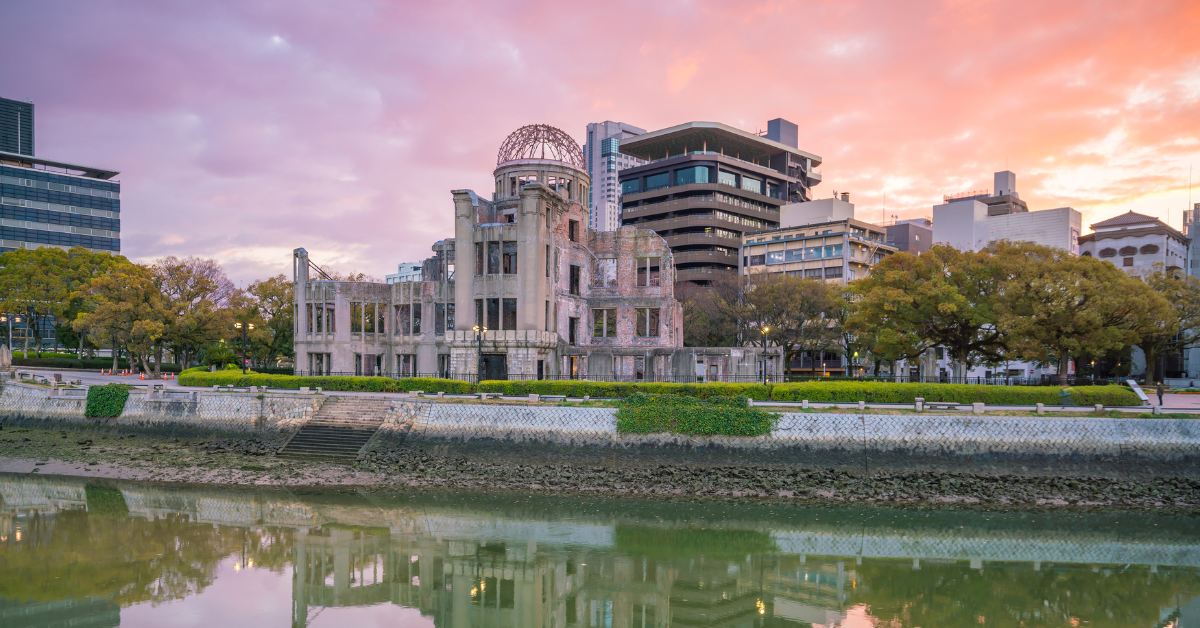In 2025, we mark 80 years since the atomic bombing of Hiroshima. The memory of the city disappearing in an instant, and the countless lives lost, remains deeply etched in the hearts of Japanese people. This event is not merely a “part of history” but a profound question aimed at all of us living today.
The Background and Historical Memory of the Hiroshima Bombing
Why Was Hiroshima Chosen as the Target?
At 8:15 a.m. on August 6, 1945, the U.S. dropped the atomic bomb “Little Boy” from the B-29 bomber Enola Gay, instantly devastating Hiroshima. The city was selected due to the concentration of military facilities and its topography, which made it easy to measure damage. However, approximately 140,000 civilians died, turning the strategic logic into a humanitarian tragedy.
| Item | Details |
|---|---|
| Date and Time | August 6, 1945 at 8:15 a.m. |
| Country | United States of America |
| Bomb Name | Little Boy |
| Damage | Over 140,000 deaths (about half of the city’s population) |
| Stated Reason | Military target, strategic topography |
The lingering question—was the atomic bomb necessary to end the war?—still weighs heavily on Japanese minds. The possibility that other options existed is frequently raised, challenging the historical narrative that justified the bombing.
The Complex Emotions Japanese People Hold About the Bomb
Even 80 years later, Hiroshima remains a profound national memory. For many Japanese, the atomic bomb represents not just war, but the loss of daily life.
Here’s a generational breakdown of perspectives:
| Generation | Key Perceptions About the Atomic Bomb |
|---|---|
| Those who lived through the war | Anger, vivid memories, strong calls for peace |
| Baby Boomers to 1980s | Responsibility for passing on the memory, involvement in education |
| Younger Generation | Emotional distance, but growing awareness via media and school |
Preserving this memory is not just a duty, but a societal responsibility.
Experts warn that apathy is more dangerous than confrontation—forgetting invites repetition.
80 Years On: Honest Feelings and Internal Conflicts Among Japanese People
The Unfiltered Views of a Generation Without War Experience
For younger Japanese, war and nuclear attacks often seem like distant historical events. It is difficult to grasp the devastation through textbooks or social media alone.
Here is a summary of sentiments among today’s youth:
| Emotion / Awareness | Description |
|---|---|
| Indifference | “It feels like history. Not really related to me.” |
| Confusion | “War is bad, but the bomb ended it. I’m conflicted.” |
| Awakening | School trips and survivor stories stir deeper reflection |
The challenge now is to bridge this emotional gap with meaningful, modern storytelling.
Is an Apology Necessary? The Misalignment of National Sentiments
The U.S. continues to hold the view that the bombings were “necessary to end the war.” Meanwhile, many Japanese feel that “the indiscriminate targeting of civilians cannot be justified.”
A comparison of perspectives:
| Perspective | Japan’s Stance | U.S. Stance |
|---|---|---|
| Purpose of the Bomb | Unjustified attack on civilians | Justified to hasten end of war |
| Apology | Needed for healing and as a symbol of remorse | Seen as unnecessary for a historic decision |
| Families’ Emotions | Lingering sorrow and pain | Growing understanding among some Americans |
The gap in historical perception cannot be closed by an apology alone—mutual dialogue and empathy are essential.
Passing Peace to the Future: What We Can Do
The Importance of Memory and Education
Education plays a vital role in ensuring memories are passed down. In addition to traditional methods, modern tools like digital archives and virtual reality are gaining attention.
| Method of Passing Memory | Impact |
|---|---|
| Survivor Testimonies | Emotional engagement, direct sense of reality |
| Digital Archives | Accessible to youth, scalable and preservable |
| School Trips | Physical presence enhances imagination and empathy |
| VR and Immersive Media | Allows time-transcending and universal experience |
These methods foster not just one-time learning, but continuous awareness—essential for building a peaceful future.
From Hiroshima to the World: Spreading the Message of Peace
Hiroshima is no longer just a city that recounts history. It is now a city taking action for the future. People from around the world visit, study exhibits, and bow at memorials—each act a step toward global peace.
Peace-related efforts from Hiroshima:
| Initiative | Description |
|---|---|
| Peace Memorial Ceremony | Held annually on August 6, attended by global dignitaries |
| Hiroshima Peace Memorial Museum | Permanent exhibits of artifacts and survivor testimonies |
| Youth Peace Programs | Programs for international students and young leaders |
| UN Collaborations | Joint campaigns for nuclear abolition and awareness |
These initiatives are not just local efforts—they’re global contributions.
Conclusion
Memory is not merely about the past—it’s a compass for the future.
Time doesn’t erase memories; it challenges us to sustain them. As long as memory lives, so does the potential to avoid repeating mistakes.
Hiroshima’s tragedy is not just a wartime lesson. It forces us to reconsider what peace and human life mean in the present. Peace is not crafted by politicians or leaders alone—it grows from the quiet awareness and intention of everyday people.
The message Hiroshima continues to convey is this:
“Indifference is the true enemy of peace.”






